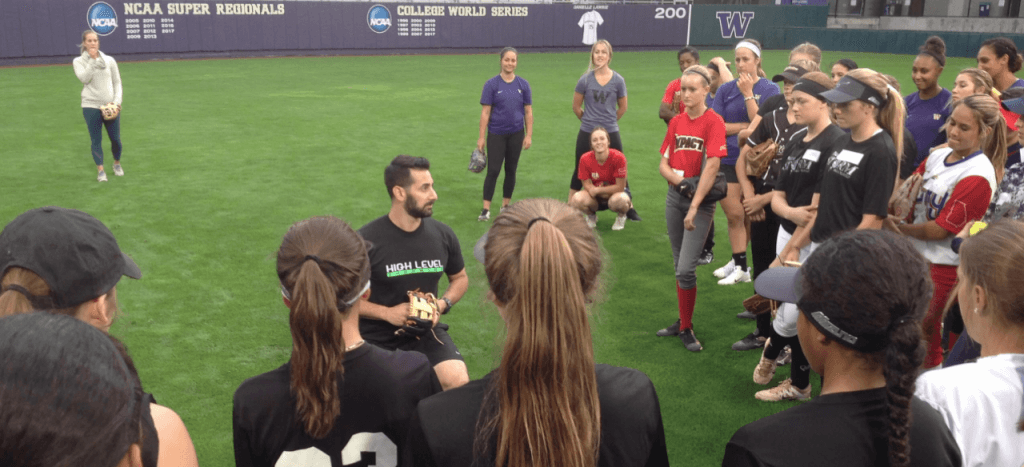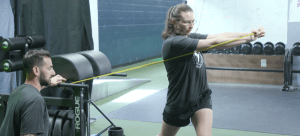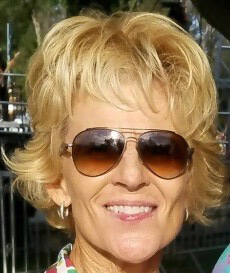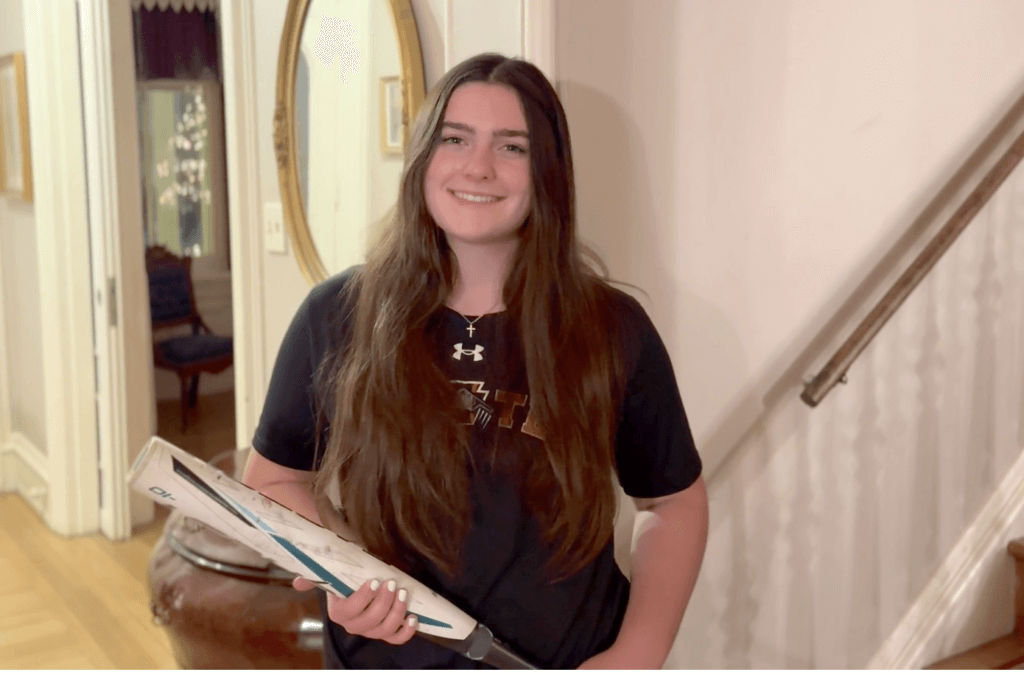
In the movie The Horse Whisperer, a horse trainer figures out how to transform horses with any variety of issues that no other trainer can resolve.
Austin Wasserman does the same thing by transforming softball and baseball athletes at his two Wasserman Strength locations, one in Florida and the other in New Hampshire.

Athletes come to him to improve their overall strength and athleticism and also to correct their throwing mechanics. Wasserman focuses on fully developing athletes from a strength and conditioning standpoint.
“Science shows us stronger and well-conditioned athletes, along with improved biomechanics, will reduce stress on the body and injuries,” he explained.
The coach, trainer and author uses a mix of evaluation, a calm demeanor, a foundation of thoroughly understanding the complicated biomechanics of throwing, a targeted strength and conditioning program, and an endearing personality combining patience and understanding.
Wasserman turns all of this into relatable lessons that help athletes with problems throwing the ball. As a result, he is a rising star and the hottest throwing consultant in college and travel softball and baseball.
“I pray he stays in fastpitch,” was the first thing softball legend Sue Enquist said.
Enquist, who won 11 National Championships as a player and head coach at UCLA and today runs ONE Softball, a free softball training resource for coaches and players, added, “One of the most neglected things in softball is a true understanding of what it means to be able to throw correctly. It’s a very complicated thing.”

“God bless our moms and dads who coach,” the UCLA legend continued, “but it’s not just turn, flex your hips and throw. Because of the complicated movements, I encourage parents and coaches, especially at the early levels to do research and understand how to get the biomechanical movements correct.”
“Austin Wasserman is one of the few people who truly understands this and can relay it in terms that everyone from an 8U player to a parent can understand.”
University of Washington softball coach Heather Tarr added, “Early development of proper throwing mechanics at the 8-to-12 year-old level is crucial to giving kids a chance to play the game longer.”
“I appreciate that he respects and cares about softball. The softball community needs to take advantage of his knowledge and interest in our game.” — Heather Tarr
BUT, REALLY, WHO IS AUSTIN WASSERMAN?
Wasserman is a certified strength and conditioning specialist with a focus on kinesiology. He uses his background and experience to help improve performance in softball and baseball players. He has spent years learning and perfecting his craft.

Originally from Brooklyn, Wasserman moved to New Hampshire when he was young. He played many sports growing up and ended up playing baseball in college at both the University of New Orleans and University of Connecticut. He also plated two years professionally in an independent league before deciding to focus on a career in performance training.
If you’re a follower of Alabama Crimson Tide Coach Pat Murphy or Coach Tarr on Twitter, you will know they both use his drills and techniques to help their teams improve their mechanics and reduce injuries during the long college season.
Murphy said, “Austin is one of the preeminent experts on throwing in the country. What I love most about him is his excellent demeanor with not only the student-athletes, but also the parents and coaches.”
“Austin can communicate with anyone. Basically, he’s just a good guy who knows what he’s doing.” — Patrick Murphy
Tarr said, “In 2015 or 2016 I randomly saw some of the things Austin was posting online. The first thing that drew my attention was that he was using a female athlete to demonstrate his point in his video. I started looking at other things he posted, subscribed to his online book, followed his social media accounts and began using some of his drills and techniques with our players.”

“I also speak frequently at coaching clinics and I started using his material and crediting him there as well. It wasn’t long until I was getting positive feedback from coaches across the country who were also just finding out about Austin.”
“It’s become clear that he’s changing the way throwing is taught, and the more his methods are used, the better it will be for softball athletes.” – Heather Tarr
“We ended up bringing him in to do a session at one of our camps. Our introduction of him to the campers was that this is the expert who developed the drills we use with our players here at Washington. That got the campers’ attention very quickly.”
Current two-time USA National Team member and former University of Alabama All-American Haylie McCleney first met Austin at the Women’s College World Series in 2018 but had followed him online for a long time.
“When you meet an internet ‘expert’ many times there is nothing there,” she began.
“What stood out to me was that Austin could back up his value. He can put it in a way that even a five-year-old could understand what needs to be done. I learned more in that 90-minute first meeting than I could have in reading text books for a semester.” — Haylie McCleney
“I went to see him in Florida where he was working with some young softball players,” McCleney continued. “The biggest thing that stood out to me, was that they had all been coming to him for a while, and all of the kids moved well, almost flawlessly. Every movement was precise and athletic. If something was wrong, the kids were attentive and listened and immediately applied, it. Both he and they paid attention to every detail. Austin makes them want to move better.”
FROM THE BEGINNING
It hasn’t been an overnight transition to success for Wasserman, however.

“I had the opportunity to work in New York City at the U.S. Athletic Training Center as an assistant physical therapist,” the native New Yorker remembered. “I learned a ton as high-profile male and female patients with all sorts of injuries and surgeries from many different sports came in. This helped me understand how the body works, how injuries occur and how the body recovers.”
It was a difficult start, though, in some ways.
“I didn’t have a place to stay, so I often slept on the training tables in the facility,” said Wasserman. Sometimes he also stayed at his grandparents’ home in New Jersey where he had to get up at 3:45 am, take a bus and then a train to get into the city by 6 am. He did this rotation for two years. He says it was a means-to-an-end to get an education.
Wasserman received his Bachelor of Science degree in Exercise Science with a concentration in Strength & Conditioning through the University of Connecticut’s Department of Kinesiology. He also received his Master’s in Human Nutrition through the University of Bridgeport.
Additionally, he is a Certified Strength & Conditioning Specialist (CSCS) through the National Strength & Conditioning Association and has been training athletes for the past 15 years.

Wasserman founded Wasserman Strength and began doing evaluations and training of local athletes to help them become stronger and faster. He also began writing a lot and posting to online forums to help players, coaches and parents.
It was during one of those evaluations that he asked his athletes to swing and throw for him.
“I realized a lot of their movements and skill patterns were really inefficient,” Wasserman recalled. “They had poor rotational ability, sequencing, and patterns. I didn’t know what was wrong, just knew that it wasn’t right. I contacted a lot of coaches, orthopedic doctors, physical therapists, athletic trainers and asked: ‘Are you seeing a lot of these faulty throwing mechanics?’”
“I also asked if there was anyone out there that was teaching throwing mechanics to non-pitchers (position players). They didn’t know of anyone who specialized in that type of training.”

What Wasserman found ended up being a niche opportunity for him in providing a platform to help thousands of youth, travel, collegiate and professional players. His High Level Throwing program began because no one was addressing the issue of poor mechanics of overhand throwing.
Today, his mission is to create better movement patterns and throwing protocols for overhand throwing athletes to help reduce the risk of shoulder and elbow industries.
Wasserman continued, “Throwing coaches out there were perpetuating the same old concepts that have been part of the problem. Orthopedic doctors told me they’d been seeing a lot of these injuries from poor throwing mechanics.”
“I thought maybe these athletes were being taught incorrectly. I set out to fix this without being a jerk. I needed to find out if there was a better way to teach position-specific throwing.” — Austin Wasserman
Wasserman said his two “ah-hah” moments came from working with a softball player.
“It was one of first assessments I did. She is in college now, but back then she looked like a one-year-old trying to throw. Here I had a 12-year-old who was only throwing 38 mph with awful mechanics. We worked together to create different ways to get her mechanics back on track. It took time. It was progressive over two years. It was during this time period, around 2010, that I thought to myself, I can do this faster and more efficiently and help a lot more youth, high school and college athletes.”
THE WATER BOTTLE DRILL
“At the time, I didn’t know how to train the arm pathway,” Wasserman admitted. “I immersed myself and read research papers and text books on muscle activation and skill acquisition. I watched a ridiculous amount of video on sports ranging from tennis and volleyball, to javelin, cricket and jai alai. I really started to understand the arm pathway by seeing these sports cross-pollinated with similar arm patterns and sequencing.”
That’s where the water bottle drill came from.
Wasserman explained how the drill originated.
“As I was drinking a bottle of water and working with a softball athlete who did not understand the arm action, I remembered the fluid movement of the arm pathway in all those videos I’d watched. So, I tried to get her to understand what the arm action needed to do using the water bottle and flow of the water.”
“I had her hold a water bottle through her motion to hear and feel the water shift when she brought her arm back and this completely changed her arm pathway. Something biomechanically was going on and the changes we implemented were working because her pain went away. That let me know I could help a lot of people,” said Wasserman.
Wasserman eventually wrote an article on why wrist flicks are problematic and lead to arm pain.
“I wanted to create awareness to the problem in the softball world. I wanted to challenge coaches on warm-up routines. That article went viral through forums and social media at the time.”
“My intention was to create a different way for coaches to think.” — Austin Wasserman
A few years after Murphy’s Alabama softball team won the national championship, the title-winning coach reached out to Wasserman and told him he’d been coaching for 20 or 30 years and he thought there might be something to what Wasserman had written about softball overhand throwing. He offered to bring Wasserman in to talk to his staff.

“I was very nervous presenting to Coach Murphy because he’s a legend. It was scary and cool at the same time. He understood it when I laid it out for his staff and he started talking about it and sharing it with colleagues and other college coaches started contacting me. My work with Coach Murphy resulted in new drills that minimize excessive and wasted movements in the throwing motion.”
“Coach Murphy gave me the opportunity and a platform to talk about High Level Throwing, potentially changing the way coaches teach throwing instruction and mechanics,” said Wasserman.
Wasserman has now done clinics for over 30 college programs and travel organizations. He speaks at softball and baseball coaches’ conventions, still finds time to write for softball sites, contribute content to ONE Softball and frequently posts on his Twitter page @WassStrength.
MORE FROM SUE ENQUIST
Enquist laughs now when she talks about meeting Wasserman for the first time. She was doing a clinic for a colleague, Denise Davis at Planet Fastpitch in Uxbridge, Massachusetts, when Davis suggested Enquist speak with Wasserman. Enquist said she really just wanted to focus on the clinic she was there to do, but Davis won her over saying Wasserman was a trainer who specialized in throwing mechanics.
“I was in the middle of building ONE Softball, which is a group of trusted advocates for the softball community,” Enquist said. “Reluctantly, I agreed after Denise insisted I speak with him. I had a really great first impression of him on the phone. He offered to drive down from his home in New Hampshire to meet me. I asked Denise how far it was, and she said it’s a really long way. So, if he was willing to drive four hours to meet me, I felt obligated to give him an hour of my time,” said Enquist.
Wasserman’s recollection of the meeting was similar.
“I drove down to Planet Fastpitch to meet with her. I was going to do a one-on-one power point presentation for her, but she immediately started grilling me and asking tons of questions: ‘Why this?’ Why that?’ It was one of the scariest moments of my career at that point, but it turned out great.”
Enquist remembered the meeting.
“I’m in a mood when he got there and I’m going to go right at him and to see if he has biomechanical understanding, but, more importantly, can he simplify it for the softball family? Integrity questions he hit out of the park. It’s easy to discern when someone speaks honestly about their values when it comes naturally. I asked him pointed questions about what it means to be trusted. Why would I pick you over the known strength and conditioning entities out there? He never got defensive.”
After that meeting, Enquist said she was very comfortable with him.
“I wanted to hook him in as our subject matter expert at ONE Softball for throwing. He said, ‘Tell me what you need.’ I told him ONE Softball is run by a consortium of volunteers. We have the best in the game giving away content. Not going to be able to pay you, but I am giving you access. He told me he was in. I told him I need 15 videos by Friday. He sent me 30 by Thursday.”
“His integrity and knowledge, and more importantly, how he applies knowledge to youth and college teams shows immediate improvement right away. Not many can engage like that and be effective with kids across all age ranges.” — Sue Enquist
“He never once said, ‘What am I getting in return?’ Never once asked that. When you have passionate educators, their drive is to share knowledge, it’s not to climb the ladder. He’s one of those unique people where his passion for teaching exceeds his ego and his need for financial success. That’s very rare.”

Enquist concluded with this: “The greatest teachers create an environment for emotional safety. For women and men, for boys and girls, this is a skill that all genders benefit from. Austin creates the conditions to make it simple and enjoyable and those are the best conditions to learn. His bandwidth of influence covers the life-cycle of the student-athlete.”
As three National Championship college coaching legends can attest, Austin Wasserman is challenging the culture of throwing in softball and baseball with humility and an endearing approach to young athletes. As a result, he is able to effectively communicate with all levels of players.
He truly is becoming “The Throwing Whisperer.”
Kevin Long is a correspondent covering travel teams, high school ball and other assignments for Extra Inning Softball. He can be reached at [email protected], www.twitter.com/KLEXINSB, and www.facebook.com/KLONG50extrainningsoftball











